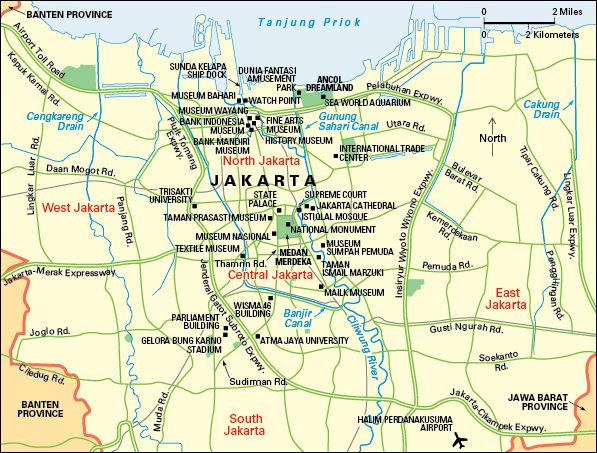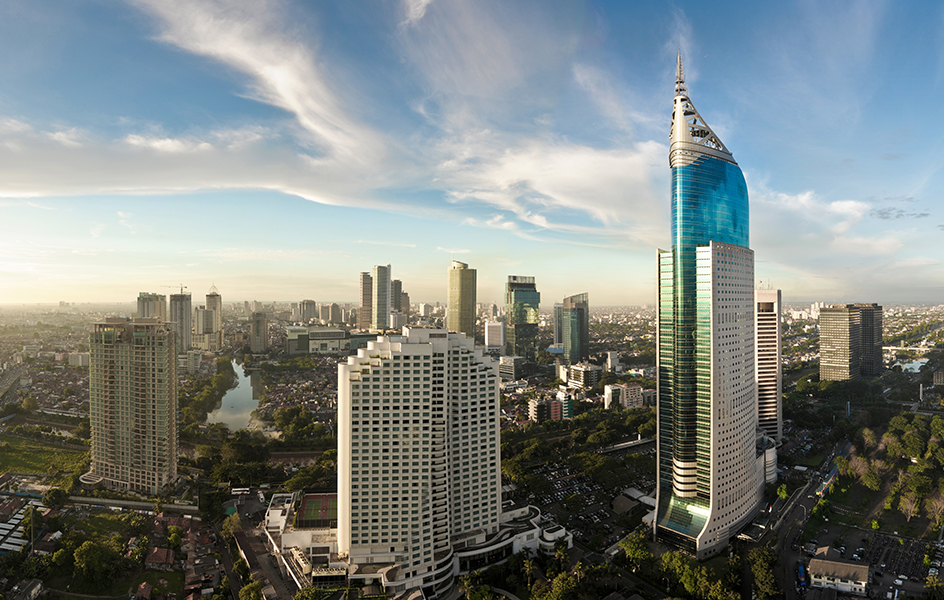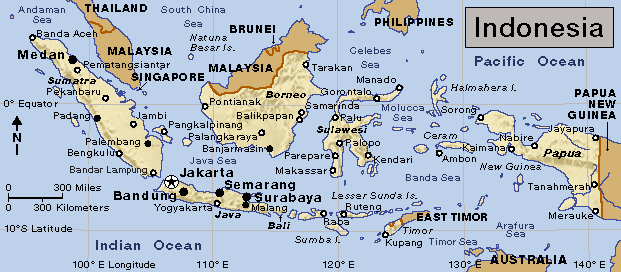Jakarta << juh KAHR tuh >> (pop. 10,562,088) is the capital, largest city, and chief economic center of Indonesia. Jakarta, sometimes spelled Djarkata, lies on the Ciliwung River, on the northwest coast of the island of Java.

The city.
Many modern hotels and office and government buildings surround Medan Merdeka (Freedom Square) near the center of Jakarta. A national monument rises 449 feet (137 meters) above the square. The monument honors Indonesia’s struggle for independence from the Netherlands, which ruled the country during most of the period from the 1600’s to 1949. Jakarta’s main business district and some industries are in the northern part of the city. Major industries also operate on the southern and eastern edges of Jakarta.

Wealthy Jakartans once lived in a Dutch-built residential section called Menteng. Today, these people make their homes in Pondok Indah and other fashionable residential areas in the south of Jakarta. However, many people in Jakarta live in small wood or bamboo structures in districts called kampongs. These areas lack clean water, sewers, and electricity.
Jakarta has several cultural and recreational attractions. Its best-known museum, the Museum Nasional, houses Indonesian archaeological treasures. The Taman Ismail Marzuki is an art center that features art exhibits, theatrical and musical performances, puppet plays, and a planetarium. Many sports events are held in the city’s huge stadium. Jakarta has many universities, of which the best known is the University of Indonesia.
Economy
of Indonesia is centered in Jakarta. The city’s harbor, Tanjung Priok, handles much of the nation’s foreign trade. Factories in Jakarta assemble motor vehicles; process food; and manufacture chemicals, electronic equipment, paper and printed materials, textiles, and other products. The government employs many people, although private businesses are growing.
Automobiles, buses, taxis, trucks, and motorcycles crowd the streets of Jakarta. An electric railroad serves the city. In 2019, the first sections of two new commuter transport lines, the MRT (Mass Rapid Transit) and LRT (Light Rail Transit), opened. The rail lines are intended to help reduce traffic in the city. The Sukarno-Hatta International Airport at Cengkareng lies west of the city.

History.
The area of what is now Jakarta was settled as early as the A.D. 400’s, probably by Sundanese people from other parts of Java. In the early 1500’s, the Portuguese established a trading post in the area but were soon driven out by local Muslims. In 1527, the name of the town was changed from Sunda Kulapa to Jayakarta.
Dutch and English trading companies built outposts in Jayakarta during the early 1600’s. Jayakarta was destroyed in 1619, when the Dutch defeated the English in a battle for control of the area. The Dutch named the city Batavia. During the 1800’s, Batavia expanded southward and became a major port.
The Japanese occupied Batavia from 1942 until their defeat in World War II in 1945. Indonesian nationalists then declared independence. The Dutch tried to reassert authority over Indonesia and regained control of Batavia in 1946. However, in 1949, the Netherlands recognized Indonesia’s independence, and Batavia was renamed Jakarta.
Jakarta’s population grew rapidly. This growth resulted in overcrowding and a shortage of jobs. City officials took steps to solve these problems. In 1970, for example, the city’s governor banned new immigrants from settling in Jakarta unless they already had jobs in the city. But the ban had little effect. Population growth and congestion continued into the 2000’s.
In 2019, Indonesia’s government announced a plan to build a new capital, partly because of overcrowding in Jakarta. Construction of the new city, Nusantara, began in 2022 on the island of Borneo. Nusantara was expected to replace Jakarta as Indonesia’s capital in 2024.
